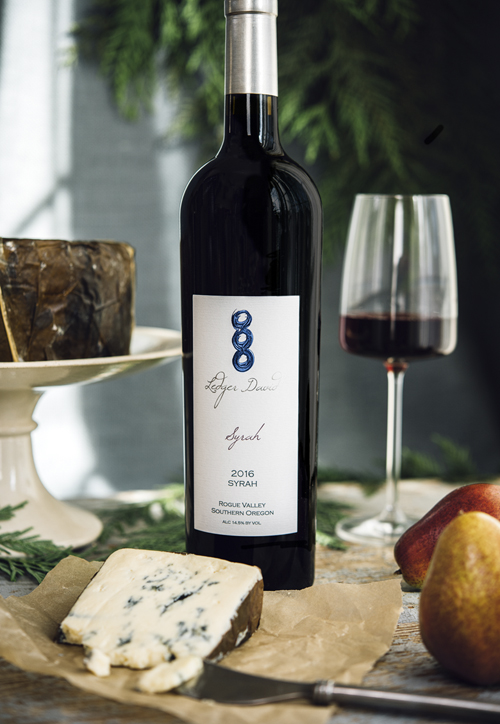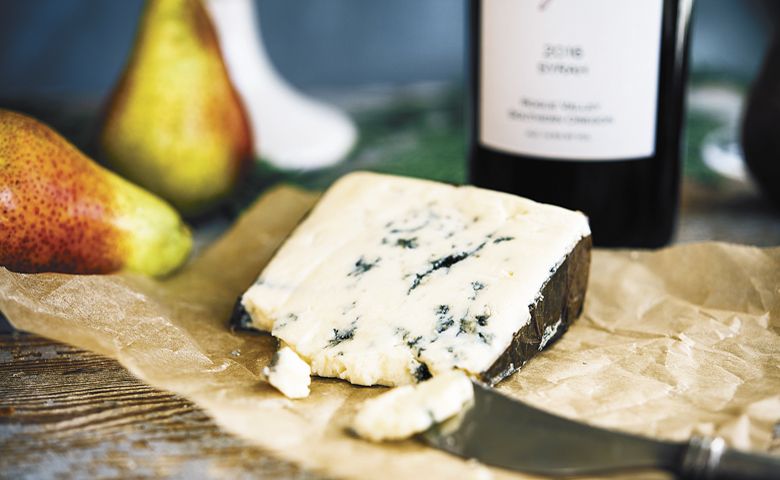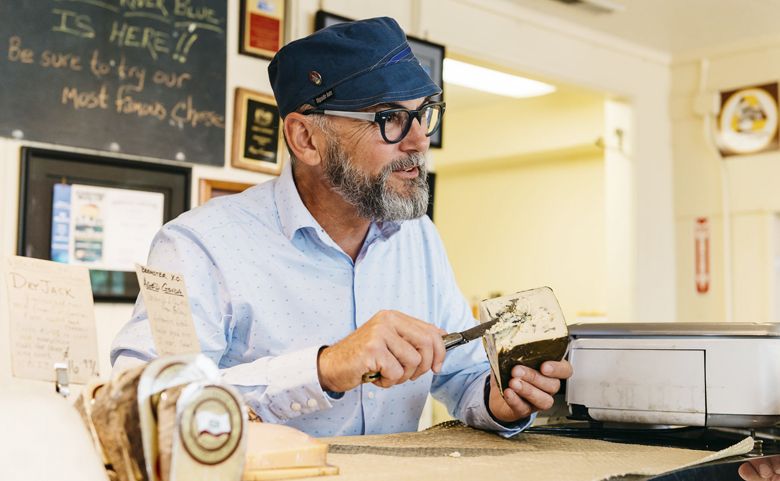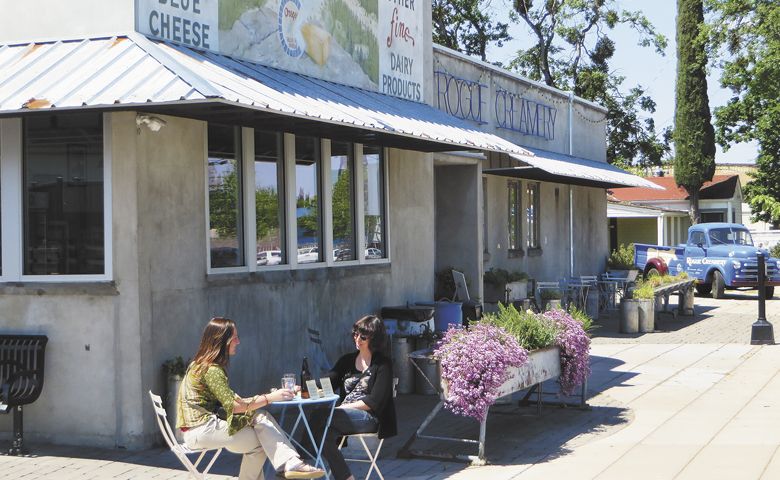Blue Christmas
Celebrate the holidays with Rogue Creamery’s world-winning cheese
In late October, as many Oregon winemakers finished their final press loads of the vintage, an announcement was made in the Lombardy region of northern Italy. From a gastronomical standpoint, it was on par with — if not altogether above and beyond — what major European competitions in the 1970s did for New World wine.
From the hilltops of Bergamo, Rogue Creamery’s Rogue River Blue was pronounced the best cheese in the world. And not just by a few enthusiasts with access to the Southern Oregon producer’s storied cheese. This was the official verdict from the 2019/2020 World Cheese Awards. No American cheese had ever taken gold. Of the sixteen finalists in this year’s competition, Rogue Creamery was the only domestic outfit.
Out of 3,804 entries from more than 40 countries, the pride of Central Point prevailed. The Judgement in Bergamo, as it can rightfully be called, will, no doubt, change the American cheesemaking landscape. But for anybody familiar with Rogue’s signature lineup of personality-driven blue cheeses, taking top prize at the “Oscars of cheese” is not entirely unexpected.
When the announcement was made, David Gremmels was bucking hay into the feeder for his calves. Rogue Creamery’s president, known affectionately as Mr. Blue, started to get some phone calls. Then, a Facetime came in but it was a bit choppy. Gremmels moved toward the Wi-Fi coming off his house for a better signal. It was renowned cheese guru Jason Hinds of Neal’s Yard Dairy, London’s foremost cheese retailer.
“He said, ‘David, you did it!’ And I was like, ‘Did what?’” Gremmels recalls. Hinds told him that his cheese was hands-down the best. Surely, that meant best in a specific category. After all, this was the same competition that featured the likes of Italy’s Consorzio Conva and Spain’s Queseria Doña Francisca. At the same time, Rogue’s most famous export had been turning heads all over the globe since 2003.
In reality, the organic cow’s milk cheese wrapped in grape leaves and cave-aged in a cave for almost a year was crowned king of all cheeses, anywhere.
Rogue Creamery started in 1933. The devastating ripples of the Great Depression lingered still. The dairy was a bit of a refuge, offering year-round employment while supporting local milk suppliers.
World War II erupted, and the creamery sent a steady stream of cheddar overseas to feed hungry troops. At the creamery, women took on manufacturing roles, keeping things in line as much of the workforce fought abroad. Business was booming and soon, the creamery was Oregon’s main source for cottage cheese.
By the mid-20th century, founder Tom Vella was interested in blue cheese. He dreamed of an Old World-inspired cave system for aging. He toured the famed Roquefort region of France, absorbing the blue cheese-making process from those who knew it best. By 1956, construction began to bring Central Point its own cave system for cheese maturation.
A half-century later, the next generation of the Rogue Creamery would entertain a possible sale that would breathe life back into the storied business.
Gremmels landed in Southern Oregon in 1999 with a desire to open a wine and cheese bar. The former vice president of product and design for Harry & David got his hands on a historic building in the area and began the restoration process. “I needed cheese, so I went to my local creamery,” he says. At the time, it was called the Rogue River Valley Creamery. Vella’s son, Ignacio, gave Gremmels a tour.
He was immediately drawn to the story and the cheeses. “I asked Mr. Vella if he was willing to sell me his blue cheese for my wine bar,” Gremmels says. “His response was: ‘If you want my cheese, you’re gonna have to make it yourself.’” Vella threw the keys to the building down, told Gremmels to take a good look and deliver his decision in three weeks.
Despite its impressive history, the creamery was looking directly at its own expiration date. Gremmels remembers the crew being slim and the place itself pretty run down on that fateful first tour. The creamery was in debt and facing almost certain closure.

He agreed to learn the craft, working alongside Ignacio at the creamery. The sale agreement was made shortly thereafter.
“In acquiring Rogue Creamery, I wanted to create a new generation of blue, a blue that represented a new generation at Rogue Creamery,” Gremmels says. “A cheese that reflected the region.”
Rogue River Blue is both an anomaly and a cross-section of Oregon food culture. Surveying the American cheese landscape of the early aughts, Gremmels found there was very little in the way natural-rinded blue cheese. The void served as inspiration.
He also wanted to protect that rind, so Gremmels turned to viticulture. With the help of Oregon State University and its test vineyard, he played around with grape leaves, sampling various varieties. “I was tasting different leaves, from Chardonnay to Zinfandel, and I kept coming back to Syrah,” he says. The recipe was already terroir-driven, but it was about to go into overdrive.
Looking to capitalize on the orchard flavors that thrive in Southern Oregon, Gremmels reached out to Clear Creek Distillery. His hope was to soak the leaves in order to preserve them, ultimately using them to wrap the individual wheels of cheese. With pear brandy, he could do just that, with some flavors to match.
“It took those umami, vegetal flavors that the natural-rinded wheel had but it brought in another element; it brought in that fruit element, that grape element — all of those signatures that Southern Oregon is known for,” Gremmels says. It was 2003 and a new generation of Rogue blue was born.
Gremmels recalls having no expectations upon the cheese’s release. “I knew it was distinctive and unique, and the intent in the Syrah grape leaf was to protect the rind,” he says. He notes that the rind is mainly Brevibacterium linens, which arise from the Southern Oregon environment. Milk plays the role of expressing them on the surface of the cheese.
Later that year, Gremmels submitted his work to the World Cheese Awards in London. “It was in the spotlight from that moment on,” he says. At its first major showing, the Rogue River Blue was named both best American cheese and best blue cheese in the world. Gremmels still refers to that point as the “bottle shock” moment. Rogue Creamery entered the picture in style, and the world began to see that not only was superb U.S. cheese possible, but also it was a multi-generational tradition that was finally getting some recognition.
“So many people were awestruck by that moment in cheese history,” Gremmels recalls. “That was a pinnacle for me because I received orders from overseas.” He went on to work intimately with the USDA to create the paperwork needed to export raw-milk cheese to Europe. It was the first certificate of its time issued to an American producer.
Enter celebrity status — at least from a cheese perspective. Rogue River Blue made its way to some of the most revered cheese shops on planet Earth, from Fromagerie Laurent DuBois in Paris to Simon Johnson Providore in Melbourne.
Wine admirers can respect the terroir element of Rogue River Blue. Resident cows graze on organic pastures in between long stares at the adjacent Rogue River. The wild and scenic river is also responsible for the estate’s irrigation. There’s seasonality too, as the cheese is only made while the cows are chowing down. That means a hard start of the autumnal equinox to the winter solstice — “or until that first hard freeze or there’s too much rain on the fields,” Gremmels admits.
“You can taste the terrain our cows pasture on and it’s accentuated by warm autumnal notes,” he says. Those flavors include hay, Oregon truffle, milk chocolate, vanilla and subtle hints of pepper and huckleberry. His coveted Syrah grape leaves come from Cowhorn Vineyards in the nearby Applegate Valley. The pear spirits are now made in house, after some consultation from OSU and the blessing of Clear Creek. The seed alcohol comes from Ashland before it’s mixed with an organic pear purée.
Gremmels rattles off favorite vintages like an experienced vintner. Years like 2003, 2009, 2011 and 2019 — the growing season that helped deliver the Judgement in Bergamo — jump to mind. Comparing the last two vintages, you’d think he was a cellar hand. He finds the ’18 more fruit-forward and pronounced while the ’19 displays that signature balance.
In all things artisanal, there are delightful details to consider. “It’s really interesting, the center of the wheel is bright and fruity and peppery,” Gremmels says. “Then as you get into the outer part of the wheel toward the rind, you get those savory, almost bacon fat-like notes.”
The creamery creates quite a few riffs of blue and other cheeses. Something unique about Rogue River Blue, aside from how it’s made, its terroir, and its seasonality, is its all-hands-on-deck requisite. “This cheese is a cheese that the entire team at Rogue Creamery participates in creating,” he says. Gremmels considers it more of a celebration, kicking off an entire vintage of Rogue River Blue. “It’s a process that’s filled with pride and joy, and anticipation — of all the flavors that will develop and meld in this wheel of cheese each year.”
It was the 2019 version of the cheese that took top honors in October. The cheese is salty, nutty and bursting with character. It possesses an almost endless finish, one that’s rich and round, with a bit of earth and a touch of malted milk chocolate. Unsurprisingly, the vintage is sold out but more wheels will be rolled out when the cheese is released again in September 2020. Those planning ahead can visit Rogue Creamery’s website to pre-order and ensure they get some before it sells out, again.
Cutting corners in the pursuit of fame is a story as old as they come. Yet, Rogue had held fast to its mission, one that’s cognizant of its social and physical environment. The creamery is certified organic by Oregon Tilth and is the state’s first B-Corp. “We believe in doing business as a force of good,” Gremmels says. “We use cheese as that force of good.”
As for the big honor, Gremmels says it’s embraced very seriously and shared among the entire community. He says, “It puts not only cheesemaking in America on the map, but food in America on the map. It’s a moment we can all be proud of and take ownership of.”
Blue Pairings
Mr. Blue recommends going from dry to rich, tasting a number of varieties and wine styles to truly take in the Rogue Blue’s layers of flavors. Here are a few Southern Oregon options OWP suggests to further enrich the complexity this cheese
already expresses:
Foris Gewürztraminer — This aromatic white boasts a rich texture and clean, peach-like flavors. It brings out the more delicate elements of the cheese.
Cowhorn Viognier — A beautiful citrus and beeswax-driven wine that lifts the cheese nicely. This wine tends to go fast, so look for one of the label’s white delicious blends if you can’t find it.
Brandborg Riesling — With a bit of residual sugar, the medium-dry Riesling Brandborg creates greets the richness of the cheese with open arms.
Ledger David Syrah — There are Syrah leaves on the rind so why not Syrah? This one is concentrated and balanced, playing off the fruitiness and pepper qualities of the cheese.
HillCrest Tempranillo — Here, an iconic Oregon label meets an iconic Oregon cheese. The wine activates some of the cheese’s gorgeous savory notes.
Abacela Albariño Blanco Dulcé — This dessert wine is candied nectarines in a bottle, with a lingering zap of acidity. It offers a syrupy counter to the cheese while bringing out its beery and fruit notes.
Troon Insomnia Port — Port and blue cheese is a classic combination. So it almost goes without saying that this one from the good folks at Troon is the perfect way to enjoy the cheese as a nightcap nibble.
Jacksonville Inn Rogue Creamery Blue Cheese Crème Brûlée
Yields 4 portions
Ingredients
2 cups heavy cream
6 oz Rogue Creamery blue cheese
¼ teaspoon kosher salt
* pinch of black pepper
8 egg yolks
2 ounces turbinado sugar
* pumpernickel bread
Directions
- Scald cream with salt and pepper.
- Stir in ½ the crumbled blue cheese until melted.
- Temper in egg yolks and cool this custard in ice bath.
- Select desired crème brûlée dishes and line the bottom with a few crumbles of blue cheese.
- Fill ramekins with cooled custard cream and place in shallow water bath.
- Bake at 300°F for 30 minutes.
- Chill in fridge to firm the custard.
- Then brûlée with turbinado sugar as per normal crème brûlée procedure.
- Serve with pumpernickel toast points.












